Garlic production
Learn the basics of garlic production including varieties, planting, harvest, site preparation, pest control and weed management.
In Ontario, garlic, a cool-season crop, is planted in the fall and harvested the following summer. This Factsheet provides information on the types of garlic grown in Ontario, garlic production from planting to storage, and pest control and weed management.
Garlic (Allium sativum) belongs to the Alliaceae family, the same family as onions, shallots and leeks. The majority of Ontario-grown garlic is sold to the fresh market as whole, fresh bulbs, green garlic or scapes. Processed products such as garlic spreads or chopped garlic are also sold, but to a lesser extent.
Types
There are two types of garlic grown in Ontario — hardneck and softneck. Hardneck varieties (Allium sativum var. ophioscorodon) bolt during late spring/early summer, producing a tall, flower stalk or scape (Figure 1). Bulbils, which are small aerial cloves, are produced at the tip of scapes in place of a true flower. There is considerable variability in the size and number of bulbils produced by hardneck garlic. Bulbils may be used as planting stock, but require 2 or more years of growth to develop into marketable bulbs. Softneck varieties (A. sativum var. sativum) do not produce a scape. A general rule of thumb is that hardneck varieties are more winter hardy, produce larger cloves but have a shorter storage life than softneck varieties.
Hardneck garlic can produce anywhere from 4–12 cloves per bulb. Varieties grown in Ontario include Rocambole, Porcelain and Purple Stripe. Softneck garlic varieties produce an average of 8–12 cloves/bulb — 5–6 cloves per bulb in northern areas and 40 or more per bulb in warmer, southern climates. Softneck varieties grown in Ontario include Silverskin and Artichoke (e.g., Asiatic and Turban).
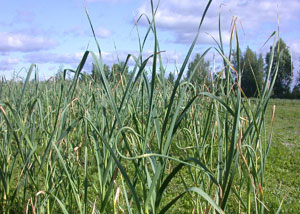
Regardless of type, cultivated garlic plants do not produce true seed, therefore, no crossing or exchange of genetic material occurs between strains of garlic. All garlic is propagated vegetatively from cloves or bulbils, with each clove or bulbil being a clone of the parent plant.
Planting
Garlic is a perennial plant that requires a cold period to initiate growth. In Ontario, garlic is grown as a winter annual — planted in the fall and harvested the following summer. Although fall planting is recommended, it is possible to plant in the spring. Place planting stock in cold storage prior to planting to allow proper bulb development.
It is critical that garlic not be planted too early or too late in the fall. Planting depth is also important. If planted too early or not deep enough, there is a risk that shoots will emerge above the soil surface and be prone to winter injury. If planted too late, there is a risk that cloves will not develop adequate root systems and will not be winter hardy. It is also important that cloves are planted with the pointed side up. Although cloves planted upside down will develop, they often have a curved shoot and misshapen bulbs.
A strong, well-established overwintering plant will rapidly develop shoot growth during spring as soil and air temperatures increase. With adequate moisture and nutrition, a large plant will develop before bulbing takes place.
Store healthy seed stock as whole bulbs until shortly before planting, since cloves separated from the parent bulb deteriorate more rapidly than whole bulbs. Dry bulbs are more easily broken apart into cloves than damp bulbs. Garlic can be cracked by hand or mechanical devices. However, there is greater potential for physical damage to cloves when mechanically cracked. Some mechanical planting equipment requires that cloves be graded into sizes or weight ranges for improved planting efficiency.
The amount of planting material required will vary from 700-1,000 kg/ha, depending upon the weight of individual cloves planted and the spacing used. Space plants 7–12 cm apart in the row. Cloves of small-bulbed strains (e.g., Artichoke) may be planted as close as 7 cm apart, while large-bulbed strains (e.g., Porcelain) can require as much as 12 cm between plants. Spacing between rows will depend on the method of planting and available equipment for cultivation. Single or multiple rows of plants are commonly used with spacing of at least 20 cm between rows.
Over the past few years, some Ontario growers have experimented with planting bulbils. Bulbils, or aerial cloves, are contained within a capsule within the top portion of the scape. Depending on variety, capsules may contain from four to a few hundred bulbils (Figures 2 and 3).
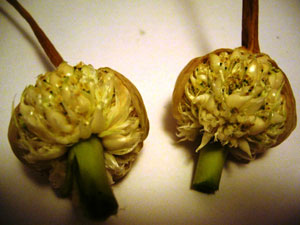
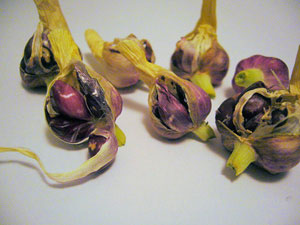
The main advantage of planting bulbils is that it allows growers to increase their planting stock very quickly and to produce seed stock free of soil-borne diseases. The disadvantage is that it can take several years of successive plantings to achieve good-sized bulbs from the initial bulbil planting stock.
Similar to garlic, bulbil capsules should be broken open and individual bulbils removed for planting just prior to planting. Planting densities for bulbils are not well established, primarily due to size variation among varieties.
Planting bulbils closer together allows for easier management but take care to provide adequate space for bulb growth. Growers in other parts of Canada have found that regular irrigation is critical for bulbil plantings due to their shallow root systems.
Planting location and soil preparation
Garlic can be grown successfully in a wide range of soil types and is grown in most cultivated areas of Ontario.
Soils with high organic matter content are preferred, due to their increased moisture- and nutrient-holding capacity. Soils containing sufficient organic matter are also less prone to crusting and compaction. Very heavy soil types hinder bulb expansion, especially if allowed to dry out, resulting in rough and irregular shaped bulbs. Intensive soil management practices are required on light sandy soils due to their low moisture-holding capacity.
Garlic grows well on fertile soils, however, fertilizer recommendations for garlic in Ontario have not been fully determined. Verify the soil phosphorus and potassium levels with a soil test. Broadcast any required phosphorus or potassium followed by shallow incorporation into the soil before fall planting. The amount of nitrogen required will vary with soil type, the previous crop grown, the amount of organic matter present and the climatic conditions during the growing season. Depending on soil type and organic matter content, it is generally accepted that garlic requires between 56–110 kg N/ha. With a small amount applied in the fall, apply half the nitrogen as soon as the garlic begins to grow in early spring and the remainder split into two to three applications at 3-week intervals. Complete the application of nitrogen within 4–6 weeks of harvest.
Do not plant garlic in soils that are prone to excessive frost heaving. Choose fields where good snow cover occurs to enhance plant survival. Choose fields that provide ample wind protection, especially where garlic is planted in lighter soils.
In Eastern Ontario, many growers mulch for the winter. Mulching helps moderate soil temperatures, and protects roots and shoots from fluctuating temperatures. While several different mulches are commercially available, it is important to ensure you don't mulch with materials that could be contaminated with garlic pests, such as bulb and stem nematode, bulb mites, diseases or weed seed. The most commonly used mulch is straw, applied 10–15 cm deep directly over the planted garlic rows (Figure 4).
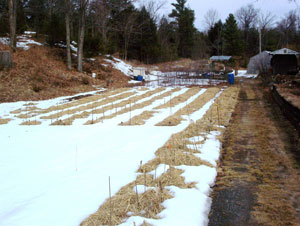
In the spring, some growers remove the mulch completely once the threat of frost is over, while others leave it on throughout the season to help maintain moisture and provide weed control.
Irrigation
Garlic is sensitive to moisture stress throughout the growing season. Periods of dry soil conditions, especially during bulbing, will result in yield reductions.
For most soils, approximately 2.5 cm of water per week is required during the growing season. In sandy soils, however, 5.0 cm or more of water may be required during hot, dry weather conditions.
The preferred time of irrigation is morning to mid-afternoon, thus allowing sufficient time for the plant foliage to dry before nightfall. Stop irrigating when garlic becomes mature and ready to harvest. This will increase harvesting ease and reduce the potential deterioration and staining of exterior bulb sheath leaves.
Scape removal
Hardneck varieties produce a scape. Research has shown that when the scape is left on the plant, bulb yields can be decreased by as much as 30%, because energy is diverted to bulbil production rather than bulb sizing. Remove scapes by pulling, breaking or cutting just after curling but before they straighten out (Figure 5).
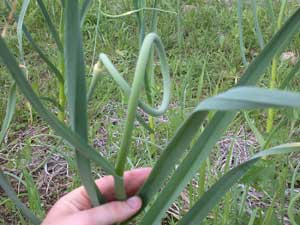
Harvest
Bulbs continue to size during late spring and summer until the leaves of the plant begin to dry, turning tan brown from the tips toward the base of the leaves. Begin harvesting when 30%-50% of the leaves have died back. Garlic bulbs harvested too early may be immature and tend to shrivel when cured, while late harvested bulbs may have stained, partially decayed wrapper leaves and/or exposed cloves.
Small plantings of garlic are often hand harvested with the aid of a fork to loosen the soil and facilitate lifting. Larger plantings are normally mechanically harvested using a tractor drawn blade that loosens the soil under the bulbs. A mechanized system can be used to lift the bulbs, remove the tops and separate the dirt and trash.
Cure garlic once harvested. Curing is the process of drying the bulb to help increase storage life by minimizing microbial and fungal infection and water loss. Leave harvested garlic in the field to cure for a couple of days or remove it from the field immediately and cure it in storage. To cure garlic in the field, place plants in covered, slotted vegetable bins and allow natural air drying. To cure in storage, tie 10-15 plants into a bundle and hang to dry in a well-ventilated area or use forced air to dry the bulbs. Once cured, trim or remove garlic tops and roots and place the bulbs in slotted bins, on wired racks, or on open trays in a well-ventilated building.
Similar to bulbs, bulbils must be cured prior to storage. Harvest scapes with the bulbil capsule intact just prior to garlic bulb harvest. Once harvested, bunch, tie and hang scapes to dry for a few weeks. Once dried, remove the bulbil capsules and store them in a dry location until time of planting.
Storage
Storage conditions depend on the end use. Garlic for consumption (table stock) can be stored differently than garlic for planting stock. Garlic for table stock is best stored at 0°C-4°C with a relative humidity of 60%-70%. Avoid storing in higher humidity, as it creates an excellent environment for penicillium mould and root growth. Table stock stored at room temperature may dehydrate faster. Store garlic intended for planting stock at anywhere from 10°C to room temperature with 60%–70% relative humidity.
At room temperature, hardneck varieties can be stored up to 4 months; softneck varieties up to 8 months. In temperature and humidity controlled conditions, storage life can be increased to 6–7 months for Rocamboles, 8–10 months for Porcelains and over 12 months for softneck types.
Pest control and weed management
Insects and diseases
There are a number of pests of garlic in Ontario, including fusarium basal plate rot, penicillium mould, leek moth, bulb and stem nematode, and viruses.
Fusarium basal plate rot
Fusarium basal plate rot attacks the basal plate region of the bulb and roots (Figure 6). This soil-borne pathogen invades the roots, resulting in empty, tan-colored, non-functional roots, while the basal plate region may develop a pinkish-brown growth of mycelium. Above-ground symptoms include yellowing of the leaf tips and dieback of the shoot during the spring. Warm soil temperatures and high soil moisture promote disease development. Since the organism survives as dormant spores in the soil or on plant residue, rotate with non-allium crops.

Penicillium mould
Penicillium mould is the main cause of decay of garlic in storage. The disease appears as masses of blue-green growth usually first seen at the base of the bulb. The primary source of inoculum is diseased bulbs used for planting material. When diseased bulbs are cracked, healthy cloves may be contaminated with airborne spores. Wounded cloves are particularly susceptible to this disease.
Infected cloves are often invaded by secondary decay organisms such as bacteria and other fungi, masking the original pathogen. Clove rot and reduced plant stands are often the result of planting infected cloves. Warm temperatures (22°C-25°C) are optimal for spore germination and disease development. Planting garlic too early in late summer when soil temperatures are high may increase the severity of clove rot. Irrigation may be beneficial, as high soil moisture appears to suppress clove decay.
Leek moth
The leek moth is an invasive alien species of European origin that damages garlic, leeks and onions. Adult moths lay their eggs on garlic leaves and, once hatched, larvae tunnel into the leaves causing damage and leaving plants susceptible to the bacterial or fungal diseases (Figure 7). There are three generations per season: the first in June, the second in July and the third in late August. Information from Europe indicates that the insect overwinters as an adult moth in various sheltered areas and begin to emerge when temperatures reach 9.5°C.
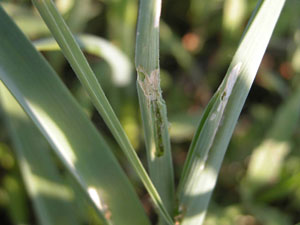
Bulb and stem nematode
Bulb and stem nematode is a microscopic parasitic nematode that enters garlic through the roots or wounds on bulbs. Early in the season, young seedlings infected with nematodes are often stunted, with yellowing and bloating of young leaves. Later infections can cause twisting of new growth, bulb softening and desiccation, and loss of roots (Figures 8 and 9). Bulb and stem nematode becomes active in the spring with damage symptoms generally appearing mid-July through harvest. The key to management of this pest is prevention. This means planting nematode-free seed into nematode-free soil. Test your soil before planting, use clean seed and follow a 3-year rotation with non-host crops. Once in the soil, bulb and stem nematode can be spread though irrigation water, on contaminated seed, equipment, humans and animals.
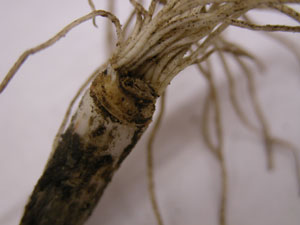
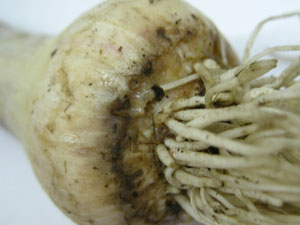
White rot
White rot is a soil-borne fungal disease that can survive as sclerotia in infected fields for decades. It is a serious concern, particularly in cool, wet growing seasons. Symptoms of white rot of garlic include a yellowing, wilting and toppling over of older leaves, watery bulbs and the presence of a fluffy, white mycelium and pinhead-sized black sclerotia, as well as rotted roots. Because sclerotia and mycelium overwinter in soil and plant debris, thorough cleaning of field equipment and proper disposing of cull garlic is important in preventing the spread of white rot to uncontaminated fields.
Viruses
Virtually all sources of garlic contain viruses, though most are latent (dormant). Latent garlic viruses may not become visible or reduce yields until the garlic plant is stressed or growth is interrupted. The most common symptoms of virus infection are colour changes of the leaves. These include mosaics, flecking, streaking and mottling. Leaf shape distortion may also occur.
Weed management
Garlic is a weak competitor against vigorous weeds. Weed management is essential and can be undertaken by cultivation, hand hoeing, mulching or with herbicide applications. Avoid deep cultivation close to the plants, as root damage and subsequent yield losses may occur. For up-to-date weed control information, consult OMAFRA Publication 75, Guide to Weed Control.